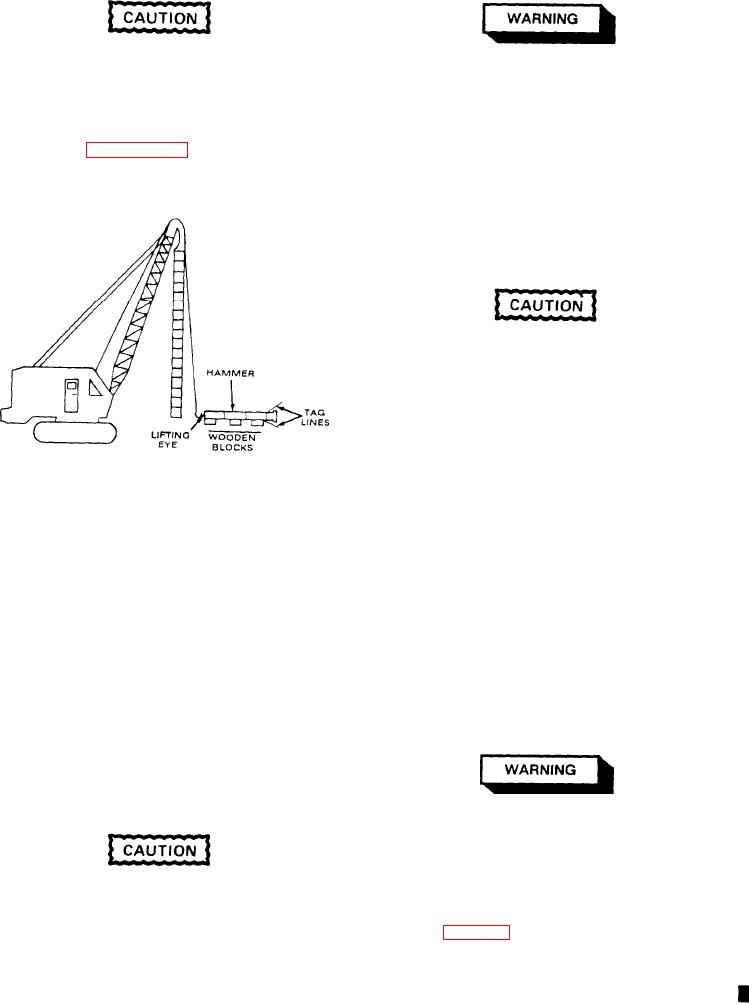
CONTROLS AND OPERATION
SECTION II
Dragging the hammer may cause damage.
Move crane at 1 to 2 mph.
6. Connect the main winch cable to the hammer
13. Raising the leads and the outriggers, move the
lifting eye. Remove the intake and exhaust port
crane (1 to 2 mph) to the site where the pile is to
covers from the hammer. Holding the tag lines se-
be driven. Lower leads and the outriggers, level
curely, slowly raise the hammer and position inside
the crane. If applicable, attach the transmitter to
the leads (see figure 2-11.3).
the operator's cab outside the door (4 bolts) and
secure bolts. Attach hoses to the hammer and
14. Attach the auxiliary winch cable to the pile,
raise the hammer just high enough to set the pile
under the hammer.
Dropping the hammer may cause damage.
15. Raise the pile, positioning it directly under the
hammer. Slowly lower the hammer onto the pile.
16. Raise the outriggers 2 to 3 inches off the
ground. Consult the hammer's TM or manufactur-
er's manual to start/stop the hammer.
17. Reverse steps 13 to 1 to remove the head and
the hammer, and to lower/remove the leads.
Figure 2-11.3. Raising Hammer
OPERATION UNDER UNUSUAL CONDITIONS
7. Attach the lead angle guides (12 bolts) to the
GENERAL. Unusual conditions refer to environ-
leads/hammer and secure the bolts.
ment; specifically, extreme cold, extreme heat,
dust or sandy conditions, areas with high humidity
8. Raise the hammer and leads 2 to 3 in. off the
or salt air, and high altitudes. Separate paragraphs
ground. Raise the outriggers and move the crane
are devoted to each of these conditions.
to within 2 ft. of the driving head. Lower the outrig-
gers.
OPERATION IN EXTREME COLD. Operation in ex-
treme cold presents special problems due to the
9. Inspect the cushions for damage, replacing
increased brittleness of metallic and rubber parts,
those that are damaged.
the danger of freezing and the increased difficulty
10. Raise the hammer just high enough to clear
of keeping parts lubricated adequately.
the head.
11. Raise the leads, then raise the outriggers (2 to
3 in.). Move the crane with the leads around the
hammer and head.
Personnel should use care to keep from
spilling fuel, coolant, or other liquids upon
themselves. Exposed parts of the body
should not come into contact with metal dur-
Dropping the hammer may cause damage to
ing cold weather, as serious and painful
the head.
injury may result.
12. Slowly lower the hammer onto the driving
1. Refer to Section Ill for lubricant recommenda-
head. Attach the head to the hammer using the
tions for cold weather operation. Change the
cables on the head. Secure cable clamps.
lubricant if necessary.
TA5015642
2-14.1
Change 1

